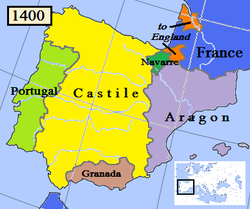Kingdom of Navarre
| Kingdom of Navarre | ||||||||||||
|
Nafarroako Erresuma (Basque) Reino de Navarra (Spanish) Royaume de Navarre (French) Regnum Navarrae (Latin) |
||||||||||||
|
||||||||||||
|
||||||||||||
|
Kingdom of Navarre in 1400 (dark green).
|
||||||||||||
| Capital | Pamplona (Iruñea) | |||||||||||
| Languages |
Basque (spoken) Latin (written) Navarro-Aragonese (administrative; spoken) Occitan Hebrew (written in Aljama) Arabic (written or formal) |
|||||||||||
| Religion | Majority religion: Roman Catholic Minority religions: Sephardic Judaism (until 1515) Sunni Islam (until 1515) Reformed (1560-1594) |
|||||||||||
| Government | Feudal monarchy | |||||||||||
| Monarch | ||||||||||||
| • | 824–852 | Íñigo Arista (first) | ||||||||||
| • | 1610–1620 | Louis II (last. French kingdom) | ||||||||||
| • | 1830–1841 | Isabel II of Spain (last. Spanish kingdom) | ||||||||||
| Historical era | Middle Ages | |||||||||||
| • | Rebelled against the Frankish Empire | 824 | ||||||||||
| • | Name changes from Pamplona to Navarre | 1004 | ||||||||||
| • | Annexed to Castile | 1512 | ||||||||||
| • | Charles I of Spain abandons the northern part | 1528 | ||||||||||
| • | Personal union with France under Henry III/IV | 1589 | ||||||||||
| • | Northern part merged into the Kingdom of France | 1620 | ||||||||||
| • | Spanish Kingdom of Navarra is abolished. Navarra becomes a province of Spain after the Ley Paccionada of Navarra | 1841 | ||||||||||
|
||||||||||||
| Today part of |
|
|||||||||||
The Kingdom of Navarre (/nəˈvɑːr/; Basque: Nafarroako Erresuma, Spanish: Reino de Navarra, French: Royaume de Navarre, Latin: Regnum Navarrae), originally the Kingdom of Pamplona, was a Basque-based kingdom that occupied lands on either side of the western Pyrenees, alongside the Atlantic Ocean between present-day Spain and France.
The medieval Kingdom of Pamplona was formed when the native chieftain Íñigo Arista was elected or declared King in Pamplona (traditionally in 824), and led a revolt against the regional Frankish authority.
The southern part of the kingdom was conquered by the Crown of Castile in 1512 (permanently in 1524), becoming part of the unified Kingdom of Spain. The northern part of the kingdom remained independent, but it joined with France by personal union in 1589 when King Henry III of Navarre inherited the French throne as Henry IV of France, and in 1620 it was merged into the Kingdom of France. The monarchs of this unified state took the title "King of France and Navarre" until its fall in 1792, and again during the Bourbon Restoration from 1814 until 1830 (with a short break in 1815).
...
Wikipedia



